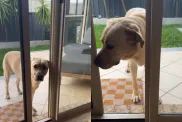Question:
Hip dysplasia–is surgery the best option?
Answer:
Treatment of hip dysplasia and the resulting arthritis may consist of surgery, weight management, medications, or a combination. Young dogs (typically less than a year of age) with a hip dysplasia diagnosis, but no signs of arthritis on x-rays, may benefit from surgery to correct the underlying problem.
This procedure–called a Triple Pelvic Osteotomy (TPO)–is aimed at repositioning the hip joints to prevent or slow the onset of arthritis. The most important aspect of this surgery is that the diagnosis be made at a young age, before the onset of arthritis.
Dogs who show symptoms after a year of age, or after arthritis develops, may also benefit from surgery. Total hip replacement surgery replaces the hip joint with metal implants, relieving the pain of arthritis. Hip replacement surgery can make a dramatic difference for a dog experiencing pain or lameness. This surgery can be quite costly.
For smaller dogs, femoral head ostectomy is another surgical option. In this procedure, the ball is removed from the socket joint of the hip, which then fills in with scar tissue, thereby removing the source of pain.
Medical management of arthritis resulting from hip dysplasia consists of nutritional supplements, anti-inflammatory medications, and weight management. Nutritional supplements such as glucosamine, chondroitin, and some fish oils may help alleviate symptoms, particularly if given before their onset.
Nutritional supplements should be obtained from your veterinarian, as these products are not regulated and may not be reliable if purchased over the counter. Anti-inflammatory medications, such as non-steroidal drugs, can also be very helpful in managing pain and symptoms. These medications are available by prescription only and your dog will need an examination and blood testing prior to treatment.
Maintaining a healthy weight may very well be the most important part of managing hip dysplasia and arthritis. Excess weight makes the pain and lameness worse, and it may hasten the progression of arthritis. Weight management alone can often mean the difference between needing surgery or not. Your veterinarian can advise you on your dog’s ideal body weight and formulate a diet plan if needed.
Ultimately, it’s the responsibility of the human–not the dog–to see that an ideal weight is maintained and to ensure a healthy, active life.









